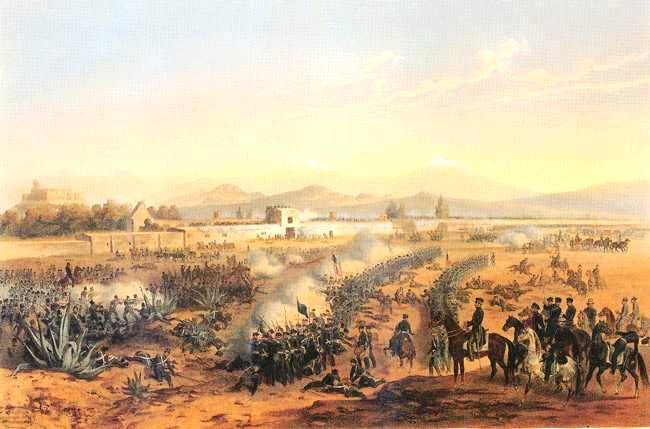ATTACK UPON THE MOLINO - September 8, 1847

Toned lithograph. D. Appleton & Co., NY. 1851.
Although Scott intended it to be little more than a raid, the Battle of Molino del Rey turned out to be on eof the bloodiest fights of the Mexican War. On September 6, 1847, as the armistice and peace talks that followed the Battle of Churubusco were breaking down, a large number of Mexican troops were observed around a group of low, massive stone buildings known as El Molino del Rey. Spread across the distance of this print, they were about 1,000 yards west of the Castle at Chapultepec (seen left), which itself was about 2 miles from the gates of Mexico City. A large grove of trees separated the molino and castle.
Scott received reports that the trees masked a foundry for casting cannon and there were rumors that Santa Anna, in desperate need of ordnance, was sending out church and convent bells to have them melted down and converted to cannon. Scott ordered Gen. Worth to attack and take the molino, break up the factory, and destroy any munitions found. When there was no response to a brief bombardment, Worth assumed the Mexicans had abandoned the buildings. He sent an assault column of 500 men, the 8th Infantry led by Maj. George Wright, down a gently sloping plain (foreground). Behind them he placed Col. Charles F. Smith's light battalion and George Cadwalader's brigade in the center, and to their right Garland's brigade and a battery under Capt. Simon H. Drum. On the left was Col. James Duncan's battery and a brigade commanded by Bvt. Col. J. S. McIntosh. These men faced the Casa Mata, a stone structure adjacent to the molino. (See next print.) Worth had a total strength of 2,800 men. When Worth's men arrived they met a fierce firefight. Six pieces of a field battery opened upon the Americans, while the heavy guns of Chapultepec and nearly 6,000 muskets from Mexican entrenchments mowed them down by the hundreds. At least half of Worth's men fell during the first barrage of bullets. Retreating, the Light Battalion and 11th Infantry sprung forward amid the clouds of smoke and deadly fire. The Mexican's works quickly fell. Although the American's first assault was rebuffed, the battle soon turned. Duncan pushed his guns in close and began bombarding the Casa Mata with a vengeance. Álvarez's men, seeing that the molino had fallen, slipped out the rear of the Casa Mata and fell back toward Chapultepec.